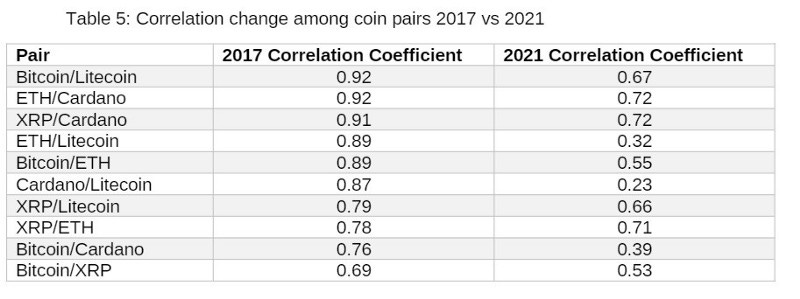Crypto portfolio in 2017 vs. 2021. What has changed over the five years?
Portfolio Theory And Its Importance
Portfolio Theory And Its Importance
One of the most prominent challenges any investor faces is deciding how to invest for future needs. Reasons can be different from funding retirement needs to future liabilities. Regardless of the purpose, all face challenges beyond just choosing an asset class. One crucial question is: Should we invest in individual securities, evaluating each in isolation, or should we take a portfolio approach. The portfolio approach or Modern Portfolio Theory requires one to assess investment in relation to its contribution to the characteristics of the whole portfolio.
Diversification is one of the most critical concepts in Modern Portfolio Theory. General investors are interested in reducing risk without reducing returns, which can be achieved through diversification.
Adding a token/coin that is not perfectly correlated with other tokens/coins can reduce overall risk. Hence the reason for diversification is simple. By creating a portfolio of tokens/coins that do not move together, we create a portfolio that smooths out ups and downs in the short perspective but continues to grow in the long run. Thus, diversification makes a portfolio more resilient to market volatility (due to mitigating asset-specific risk in the portfolio) than a single coin.
Diversification cannot “wash away” systematic risk (i.e., risk of the overall market) as it includes risk factors affecting the entire portfolio.
Another essential definition we must explain is a correlation. In simple terms, correlation is the measure of the linear relationship between two assets or, in our case, coins/tokens. The correlation coefficient is the ratio of the covariance to the product of the two variables’ standard deviations.
The correlation coefficient expresses the strength of the linear relationship between the two coins.
Now that we established the importance of the portfolio approach and basic metrics, let’s look at the hypothetical crypto portfolios constructed in 2017 and 2021 and compare correlation coefficients among coins in the portfolio and drive some conclusions from the analysis.
Top 15 in 2017 vs. 2021
Suppose we had to construct a hypothetical equally weighted portfolio of top 15 coins by market capitalization in 2017. In that case, we’d have the following composition of coins and correlation coefficients among each pair of coins:
Table 1: Composition of coins and market capitalization on 31st of December 2017
Table 2: The correlations among the coins’ prices in 2017
A portfolio constructed in 2021 with the same parameters (equally weighted; top 15 coins by market capitalization; excluding stable coins) will have a different composition of coins and correlations amongst them
Table 3: Composition of coins and market capitalization on 31st of December 2021
Table 4: The correlations among the coins’ prices in 2021
There are several points worth highlighting:
The composition has changed drastically. Only five out of the original fifteen coins remained in the portfolio. Only Bitcoin, Ethereum, XRP, Cardano, and Litecoin had enough growth to stay in the “Top 15” by market cap in 2021. Yet another excellent example of the benefits automatic rebalancing & reconstitution provide — maintain only relevant to the strategy coins in the portfolio
2. Correlation coefficients among those five coins have declined:
In 2017, all five coins showed a strong positive linear relationship with each other. In 2021 however, the correlation had declined among all pairs. It can be explained by the fact that projects have evolved into different use cases and hence departed further apart.
3. General correlation among “new joiners” is much lower than in 2017
New coins that entered the top 15 list have a lower correlation with each other. The weighted average of correlation coefficients in 2021 is equal to 0.5 compared to 0.82 in 2017 — a significant reduction, creating better diversification benefits if viewed as a portfolio.
Conclusion
The Crypto market has changed since 2017 and being in the top position once does not guarantee that a coin/token stays there forever. Hence portfolio composition can change at any point in time.
Protocols and projects evolve rapidly: “Top 15” projects in 2022 have different use cases, are implemented on different blockchains, represent various industries and locations.
We are better positioned to diversify unsystematic risk compared to 2017, given correlation coefficients showing a reduction in a linear relationship.







